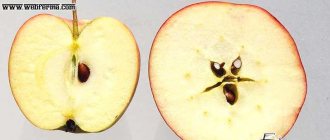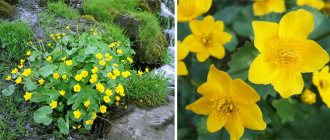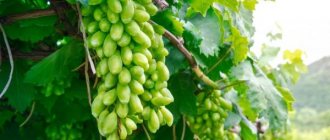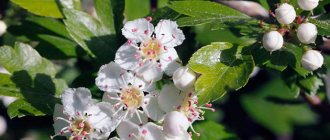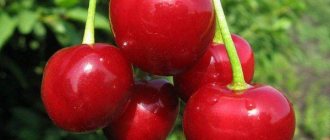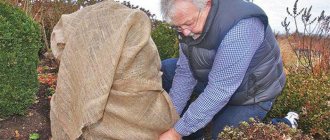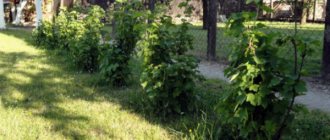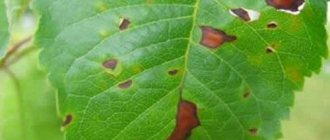Kinds
All Ostriches have vertical thick leaves. They can reach 2 meters in height. The leaves are similar in appearance to ostrich feathers, which is why this type of fern got its name. The leaves form a funnel, in the center of which there are low spore-bearing leaves.
There are several types of ostriches: common and eastern.
Ordinary
The common ostrich fern is considered the most popular. It grows quickly, is not afraid of frost and does not require special care. The leaves are wide, the fronds are light green, wide and feathery.
The common ostrich is also called varifolia or black fern due to the dimorphism of the leaves and the characteristic black color of the stem.
One of the specimens of this subspecies is pictured below:
This type of fern is included in the Red Book of several regions of Russia and Ukraine.
Oriental
The Eastern Ostrich has large fronds that are collected in bunches. The height of the fern can reach 1.5 meters. The leaves are feathery, the feathers themselves are narrow and curled. The leaf petioles are covered with brown films.
Unlike the ordinary one, the eastern Ostrich has larger feathers of the first order. But their number is somewhat less. Oriental fern is more finicky and requires regular moisture and protection from the winds.
What the Eastern subspecies looks like, see the photo below:
How does the Ostrich Feather Fern reproduce?
Is it possible to keep a fern at home?
In good conditions for growth, the bush quickly acquires children. It is important to wait until the young bush develops a good root system and can grow without feeding from the mother’s roots. Having produced several branches, the seedling is ready for planting. It must be carefully dug up and separated from the mother plant. A small bush can be transplanted into a pot for rooting, and then planted in a flower bed. It is advisable to transfer the soil from the pot to a new place of growth of the young bush.
Young children can be obtained by thinning the flower bed from overgrowth
Another method of reproduction is by spores. The bushes turn out taller, healthier and stronger. However, this procedure requires time and effort. Spores are collected on good fronds on which sori (a group of spores) are located. As soon as the sori turn brownish-brown, you can begin collecting them. This usually happens in late August - early September. They are dried and sown on a mixture of peat and leaf soil.
Ferns need a greenhouse, warmth and constant moisture. When the sprouts are 5-6 cm long, you need to start preparing them for open areas. The greenhouse should be ventilated daily, starting from 15 minutes, increasing the time each time. Bushes planted in this way are moved into open ground after 1.5-2 years. They should be looked after like adults.
Photo
See more photos of the Ostrich fern below:
Read more about common types of ferns here.
Use in landscape design
You can purchase healthy seedlings on the Internet or in a specialized nursery. The price of one seedling ranges from 300 to 1200 rubles. But you can find seed cheaper through advertisements.
The common ostrich is often used in the field of landscape design. This crop does not take root at home, so it is grown in gardens, parks and greenhouses.
The plant looks best in group plantings with other crops and combines effectively with rocky fences and boulders. It is better to plant bushes in shaded areas and on slopes on the north side. Ostrich flowers often decorate front gardens and garden paths.
Ferns coexist beautifully with spring hazel grouse, tulips and daffodils. Beautiful ostrich leaves can perfectly camouflage fading spring bulbous crops.
The common and oriental ostrich is often used as an element of winter bouquets. The spore-bearing leaves do not lose their shape for a long time and serve as an excellent addition to compositions.
Common ostrich: planting and care
At home, the most commonly used fern is the common ostrich fern , since it is more frost-resistant and grows well in both poor and rich soils.
Features of care after purchase
Ostrich is resistant to low temperatures and is not picky about soil composition. But when purchasing, it is worth considering that it will require strong hydration. The place can be either shaded or open.
Fronds are used for planting. They must be planted by covering them with soil and watering them abundantly.
Lighting
The plant is not picky about sunlight. The fern grows well both in the shade and in bright light. But keep in mind that a plant growing in the sun, even with sufficient moisture, will be small in size.
Temperature
Ostrich is not afraid of low temperatures and is therefore often used to decorate gardens in temperate latitudes.
The ostrich can tolerate temperatures down to -10 degrees.
But high temperatures of 25 degrees are unacceptable for it. The plant does not tolerate them well.
Other winter-hardy ferns suitable for growing in the garden or on a personal plot include: Bracken, Kochedyzhnik, Osmunda, Bladderwort, Adiantum, Polygonum, Shchitovnik
Air humidity
Like most types of ferns, the plant does not tolerate dry air well. In dry weather it is necessary to spray the fern.
Watering
Ostrich is an unpretentious plant, but needs a moist environment. During dry periods, it is necessary to provide it with sufficient watering.
Fertilizers (feeding)
Both mineral compounds and organic matter can be used as fertilizer. You can use them as desired, since the fern is not picky.
Transfer
Ferns should be replanted in the spring. To do this, a young plant is dug up.
If necessary, you can replant the fern at the end of summer, using a piece of the mother rhizome with a bud.
Pruning and planting
No trimming is applied.
But once every three years, Ostrich needs to be thinned out , since this perennial plant grows quite strongly. It should be used carefully in group plantings.
Rules of care
Ostrich is a plant that does not require significant care. If the site as a whole meets the needs of the plant, then with minimal care it will delight the eye with lush green bushes.
Watering
Sufficient humidity is perhaps the only mandatory requirement when growing ostrich feathers. The plant needs regular moderate watering. If the soil is very dry or the weather is hot, then the fern must be watered abundantly, and the above-ground part must also be sprayed with the rain method.
Top dressing
The ostrich does not feel the need to apply additional fertilizers. However, some gardeners note a good response to the periodic use of organic and mineral fertilizers.
Pruning, shelter for the winter
The plant does not need pruning. Instead, the ostrich bird needs to be thinned out every 3-4 years, as it grows quite quickly. To prevent the appearance of fern thickets, it is necessary to remove excess shoots.
Advice! Experienced gardeners recommend taking care in advance to limit the growth of the ostrich bird. To do this, mechanical barriers are used to enclose the landing site both above and underground.
Ostrich feathers tolerate low temperatures well, so they usually do not require any preparation for winter. If the winter is expected to be very cold, then covering materials can be used.
Reproduction
The ostrich reproduces by spores and leaves - fronds.
Disputes
Reproduction by spores is similar to propagation by seeds, but more complex and labor-intensive, but effective.
Spores are collected in late summer - early autumn.
Then they can be stored for a long time or immediately sown in containers with disinfected bedding peat, covered with glass and periodically moistened.
After 3-5 weeks, shoots will begin to appear. They are transplanted into a mixture of sand, heather soil and peat chips, where the fern grows for several more years, after which it can be planted in selected areas.
Vegetatively
For vegetative propagation, underground shoots of the plant with several buds are used. This type of propagation is used in early spring or late summer.
The shoots are planted at a distance of half a meter from each other.
Diseases and pests
Another undoubted advantage of the ostrich fern is its high resistance to various diseases, as well as the effects of insect pests.
The only danger is dense plantings combined with high humidity. Under such conditions, fungal infection is possible. It appears as dark spots on the leaves. If detected, remove and destroy the affected shoots, and spray the remaining plants with a fungicide.
Important! To prevent the appearance of fungus, it is recommended to treat the plantings with copper sulfate in the spring.
Planting in open ground
Seedlings aged 2-3 years are planted in open ground. Since the fern loves shade, the banks of forest rivers, and ravines, therefore it is necessary to plant the Common Ostrich in partial shade. In a sunny area the plant will not look as beautiful as in the shade. Landscape designers suggest planting seedlings in groups - 5 or 7 pieces.
It is advisable to plant as close as possible to natural conditions. For example, plant seedlings in the shape of an irregular triangle. The interval between plants should be from 50 cm to 1 meter. In a few years, the fern will independently occupy the free central part of the triangle. However, to prevent the plant from becoming too aggressive, it is necessary to promptly remove excess growth, creating a decorative attractiveness for the area.
Growing from spores
Ferns are the oldest plants and they appeared much earlier than bees. This fact explains the lack of flowering and the formation of spores - this is how nature took care of reproduction. Along with spores, ferns can be propagated by dividing the rhizomes.
Collection of planting material, sowing
You can determine the readiness of sporangia by the color of the frond - if it has become dark, almost black, then it is cut off and placed in a paper bag or newspaper. After a short time it will dry out and the powder-like spores will fall out. It is necessary to separate the spore powder from foreign debris so that it does not interfere with planting and does not fall into the ground. The powder is stored for a long time (5-6 years), but over time the germination rate decreases.
Germination occurs in 1-2 weeks; the formation of shoots requires about two months, and the same amount for the formation of the root system. Taking these dates into account, the recommended planting time is autumn and early winter.
Preparing the container and soil
Germination requires moisture, so it is better to choose containers with a lid. You can take ordinary food containers (0.5 l) - new ones do not require disinfection, old ones must be washed with a disinfectant.
The soil mixture should not be heavy and hold water well. A mixture of peat, sand, leaf soil (2:1:1), sphagnum moss (crush before use), and a universal mixture for indoor plants are suitable. To avoid the appearance of mold, the soil mixture must be steamed, poured with boiling water or a solution of manganese.
Sowing and care
Clean containers are filled with soil mixture to 1/2 height, spilled with warm boiled water so that the soil is saturated and the water level is below its surface. To evenly distribute small spores, take a stick or pencil, dip it in spore powder and lightly touch the surface of the soil, do not sprinkle anything on top. Frond particles should not fall into the ground, because they will begin to rot. Close the lid and place the container in a bright, sunny place.
Depending on the shelf life of the spore powder, seedlings, called shoots, may appear in a week, a month or more. The tiny outgrowth initially looks like a green ear with thin roots, but it cannot yet be called a fern. Male cells (sperm) from the reproductive organs located on the underside of the shoots enter the female cells on neighboring shoots with moisture, fertilization occurs, after which the fern begins to grow. Those shoots that are not fertilized die.
Approximately 7-30 days after the shoots appear, shoots and roots begin to develop. If during this time they have not appeared, then there is a possibility that they will not appear at all.
Care consists of ventilation to remove condensation, maintaining moisture and cleanliness of the soil - spraying with boiled water, preventing mold from appearing. If it nevertheless appears, or the shoots begin to turn brown, then be sure to treat with a fungicide.
Dense ostrich plantings can be thinned out by picking. To do this, grab a bunch of shoots with tweezers and plant them in moist soil in a separate container. If necessary, the picking is repeated.
To harden the seedlings, the lid of the container is first opened slightly and finally removed when the seedlings have become stronger. You cannot open the container right away - if the conditions change abruptly, the sprouts may die. A young fern develops at home for about two years, then it is planted on the site.
Vegetative method
It is much simpler, and therefore common among novice gardeners. Reproduction is carried out in early spring before the sterile shoots have not yet begun to grow, or in early August, when the spores ripen. A part of the creeping root, 20 to 30 cm long, is separated from the mother bush. Such a segment usually contains several buds.
Then the division is planted in a previously prepared place according to a 50x50 cm pattern.
Ostrich fern - what kind of flower is it?
The ostrich is the most beautiful of its brothers. Its bush is distinguished by carved leaves and lush greenery. The bushes of the plant are the tallest and slender among all types of fern. The rosette of large dissected leaves retains its decorative effect from early spring until late autumn.
Tall slender bushes are a decoration for any garden.
Another difference between the ostrich is the placement of spores. While all ferns have them on the lower part of the leaves, this shrub has separate fronds for spores. These branches are called sporophylls. They are short (up to 60 cm) and appear on the bushes in August. When the spores mature, the leaves turn burgundy. In spring, sporophylls bloom and are sown around the bush.
This is interesting! The fern got its name due to the similarity of the leaves to ostrich feathers. The spore-bearing branches most closely resemble an ostrich feather. These branches are dried and used in bouquets and home decoration.
Brief description of what it looks like
The ostrich's homeland is North America. It belongs to the Onokleev family. The rhizome of the shrub has a bulbous shape. Its branches develop in a circle, growing at the top of the bulb. The shoots of the shrub are long, sometimes reaching 1.5-2 m. The leaf blades are pinnate, each feather is narrow and slightly curled inside the leaf. The branches of the fern open simultaneously, and in the middle of the season the bush looks like a vase with an empty core.
Ostrich in landscape design
Ferns are often used to decorate shady areas and flower beds. Lush greenery serves as an excellent background for compositions with lower flowers on alpine slides or mixborders. The banks of artificial reservoirs and small garden ponds are decorated with ferns. They decorate the trunks of tall trees.
Green pond decoration
Plant in the household
Fern not only decorates front gardens, but is also a rather valuable plant in the household. It is not surprising for many, but ostrich can be eaten. In some areas of America, ostrich is the main dish of Indians. Only young vegetative shoots (rachis), which are up to 20 centimeters long, are used for food. It is not recommended to oblige everything at once, otherwise the fern will weaken greatly and may disappear, especially a young plant. It is better to collect from an old plant, and take no more than half from a young plant, then the fern will recover.
If the rachis breaks without a crunch or tears, then it can no longer be eaten, it is overripe. No more than 4 hours should pass from the moment the rachis was picked. Afterwards, it will become rough and unusable.
Raw rachis should not be eaten, it is very bitter. It can be boiled or pickled. The plant tastes like cauliflower, slightly sweet.
When the rachis has been boiled, it is allowed to cool a little and the unnecessary liquid is drained off. Next, you can fry it in a frying pan like regular mushrooms.
Also, ostrich can be pickled, or rolled into jars like cucumbers, in brine.
Nowadays, few people eat fern; it often serves as a decoration for the garden. Its chic appearance allows you to make any interior unique. At the same time, the plant does not require special care.
Ostrich tends to grow quickly and thickets form. Very often it is ostriches that are planted near bodies of water. In addition, the plant is very friendly, and any flowers in its vicinity will grow beautifully and create a unique look for your yard.
Ostrich in folk medicine
Ostrich is not used in the treatment of any diseases in traditional medicine. But traditional healers often use this plant as one of the main components for preparing decoctions and infusions. In order to understand what effect this plant can have on humans, you need to understand its chemical composition. As it turns out, he is quite rich:
- ascorbic acid;
- tannins;
- coumarin derivatives;
- essential oils;
- saponins;
- starch;
- alkaloids;
- fats;
- hydrocyanic acid;
- tannic acid;
- a nicotinic acid;
- carotene.
In folk medicine, both aerial parts of the plant and rhizomes are used. Ostrich can help get rid of the following ailments:
- disorders of the gastrointestinal tract;
- painful menstruation in women;
- headaches of various origins;
- sleep disorders and neuropsychic state of a person;
- helminths in the human body;
- disturbances in the functioning of the respiratory system, attacks of suffocation;
- pain syndrome of various origins;
- epilepsy and seizures;
- cough;
- mechanical damage to the skin, wounds.
Thus, ostrich, when skillfully prepared and combined with other medicinal plants, can have an analgesic, antiseptic, sedative, anthelmintic, anticonvulsant, and antitussive effect. Since ancient times, fern rhizomes have been considered a good helper for women who experience too much pain during menstruation. For external use, compresses from the leaves are used, and for internal use, alcohol tinctures and decoctions are used. When planning to use ostrich to treat any ailments, be sure to remember:
- some varieties of fern are poisonous and their independent use can be dangerous;
- Pregnant women and women who are breastfeeding should refuse treatment with such folk remedies;
- The use of folk remedies based on ostrich is prohibited in the treatment of children. This also applies to all other medicinal herbs. Such self-treatment can cause severe allergic reactions;
- Ostrich-based folk remedies will not help in the treatment of acute phases of diseases. It's always a good idea to see a traditional doctor first;
- An overdose of ostrich can have a negative effect on a person. He may feel weakness, aching bones, depression of respiratory function, slow pulse and low blood pressure, cramps, nausea, and diarrhea.
No matter what wonderful properties ferns have, they should be used for treatment very carefully and only after consulting a doctor.
Ostrich: combination with other plants
A group planting of ostrich birds is a beautiful combination in itself. When choosing other companions, keep in mind that the fern growing season begins late. In the design of plots, the camouflage properties of ostrich grass are used to hide early fading crops: crocuses, scillas, etc.
Fern in company with moss, driftwood and stumps will create a forest composition on the site. This photo-atmospheric installation will be complemented by saxifrage, primrose, loosestrife or creeping tenacious. The combination of ostrich with leopard, daylilies, decorative varieties of cereals and irises looks interesting.
Where to plant fern?
For this plant, a corner of the garden between the house and the fence is suitable, where it is not visited too often, but an attractive view from the window is very important. It is advisable that direct sunlight does not fall on the ostrich, but the place should be fairly open. If the flowerbed where you planted the plant is under the sun, then the soil should be constantly moist. True, even if this rule is followed, the plant will not reach its maximum height. In addition, the color of the foliage will be less saturated.
The ostrich bird looks very impressive against the background of birch and pine trees, among large thujas, near old apple trees, next to mock orange bushes. In addition, the common ostrich will feel comfortable on the bank of a decorative stream or any other body of water.

